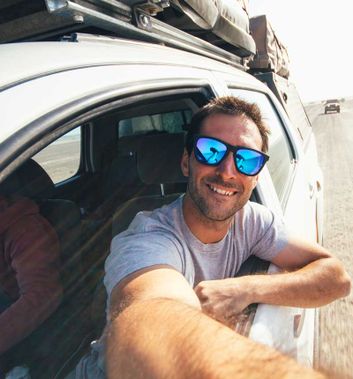CAR LOANS
Best business car loans comparison
By Megan Birot
Find your best Car Loan deal today, with rates from 5.09% (comparison rate 5.78%)
Compare 90+ Car Loan lenders – fast, easy & free
Get expert help finding your best car loan fit
Car Loan comparison guide created by our team of experts. Updated 16 Dec 2025.

Loan purpose Loan amount | ||
 | RACV Green Car LoanInterest rate from 5.09% To 5.79% p.a. (fixed) Comparison rate from 5.78% To 6.49% p.a. Money Score 3.15 out of 5 Repayments from $567.37 Per month for 5 years 1 - 7yr Loan Term $5,000 - $100,000 | Compare now on Money.com.au or visit site |
 | CommBank Go Green with a Personal Loan Secured FixedInterest rate from 5.29% To 5.99% p.a. (fixed) Comparison rate from 6.72% To 7.41% p.a. Money Score 2.73 out of 5 Repayments from $570.13 Per month for 5 years 1 - 7yr Loan Term $4,000 - $120,000 | Compare now on Money.com.au or visit site |
 | Great Southern Bank Green Car LoanInterest rate from 5.49% To 12.24% p.a. (fixed) Comparison rate from 5.63% To 12.39% p.a. Money Score 3.90 out of 5 Repayments from $572.90 Per month for 5 years 1 - 7yr Loan Term $5,000 - $100,000 | Compare now on Money.com.au or visit site |
 | Horizon Bank Green Car LoanInterest rate from 5.49% p.a. (fixed) Comparison rate from 5.71% p.a. Money Score 3.97 out of 5 Repayments from $572.90 Per month for 5 years 1 - 5yr Loan Term $1,000 - $100,000 | Compare now on Money.com.au or visit site |
 | Bendigo Bank Secured Green Personal LoanInterest rate from 5.49% p.a. Comparison rate from 5.84% p.a. Money Score 3.25 out of 5 Repayments from $572.90 Per month for 5 years 1 - 7yr Loan Term $2,000 - $100,000 | Compare now on Money.com.au or visit site |
 | Queensland Country Bank Green Car LoanInterest rate from 5.54% p.a. Comparison rate from 5.82% p.a. Money Score 4.63 out of 5 Repayments from $573.59 Per month for 5 years 1 - 7yr Loan Term $2,000 - $150,000 | Compare now on Money.com.au or visit site |
 | MoneyPlace Secured Car Loan (New)Interest rate from 5.67% To 6.52% p.a. (fixed) Comparison rate from 6.10% To 6.95% p.a. Money Score 4.61 out of 5 Repayments from $575.39 Per month for 5 years Up to $80,000 | Compare now on Money.com.au or visit site |
 | People's Choice Green Car LoanInterest rate from 5.69% p.a. Comparison rate from 6.04% p.a. Money Score 3.10 out of 5 Repayments from $575.67 Per month for 5 years Up to 10yr Loan Term $20,000 - $120,000 | Compare now on Money.com.au or visit site |
 | Harmoney Unsecured Car LoanInterest rate from 5.76% To 24.03% p.a. (fixed) Comparison rate from 5.76% To 24.98% p.a. Money Score 4.41 out of 5 Repayments from $576.64 Per month for 5 years 3 - 7yr Loan Term $2,000 - $100,000 | Compare now on Money.com.au or visit site |
 | SWSCU 5 Year Term Vehicle LoanInterest rate from 5.79% p.a. (fixed) Comparison rate from 5.79% p.a. Money Score 3.95 out of 5 Repayments from $577.06 Per month for 5 years 5yr Loan Term $1,000 - $200,000 | Compare now on Money.com.au or visit site |
 | Horizon Bank Personal Loans Secured by DepositsInterest rate from 5.79% p.a. Comparison rate from 6.00% p.a. Money Score 3.88 out of 5 Repayments from $577.06 Per month for 5 years 1 - 30yr Loan Term $500 - $100,000 | Compare now on Money.com.au or visit site |
 | Queensland Country Bank New Car LoanInterest rate from 5.79% p.a. Comparison rate from 6.39% p.a. Money Score 4.53 out of 5 Repayments from $577.06 Per month for 5 years 1 - 7yr Loan Term $2,000 - $150,000 | Compare now on Money.com.au or visit site |
 | Horizon Bank Personal Loans Secured by MortgageInterest rate from 5.79% p.a. Comparison rate from 7.84% p.a. Money Score 3.16 out of 5 Repayments from $577.06 Per month for 5 years 1 - 30yr Loan Term $500 - $100,000 | Compare now on Money.com.au or visit site |
 | MoneyPlace Secured Car Loan (Used)Interest rate from 5.80% To 6.52% p.a. (fixed) Comparison rate from 6.23% To 6.95% p.a. Money Score 4.59 out of 5 Repayments from $577.20 Per month for 5 years Up to $80,000 | Compare now on Money.com.au or visit site |
 | Move Bank Green car loanInterest rate from 5.89% To 6.25% p.a. (fixed) Comparison rate from 6.16% To 6.52% p.a. Money Score 3.82 out of 5 Repayments from $578.45 Per month for 5 years Up to 7yr Loan Term $5,000 - $150,000 | Compare now on Money.com.au or visit site |
 | NOW Finance Unsecured Personal LoanInterest rate from 5.95% To 26.95% p.a. (fixed) Comparison rate from 5.95% To 26.95% p.a. Money Score 4.54 out of 5 Repayments from $579.29 Per month for 5 years 1 - 7yr Loan Term $5,000 - $50,000 | Compare now on Money.com.au or visit site |
 | OurMoneyMarket Car LoanInterest rate from 5.95% To 18.99% p.a. (fixed) Comparison rate from 5.95% To 21.78% p.a. Money Score 4.46 out of 5 Repayments from $579.29 Per month for 5 years 1 - 7yr Loan Term $5,000 - $100,000 | Compare now on Money.com.au or visit site |
 | RACQ Bank Bank Green Car LoanInterest rate from 5.99% p.a. (fixed) Comparison rate from 5.99% p.a. Money Score 3.06 out of 5 Repayments from $579.84 Per month for 5 years 1 - 5yr Loan Term $3,000 - $150,000 | Compare now on Money.com.au or visit site |
 | SWSCU Fixed Rate Vehicle LoanInterest rate from 5.99% p.a. Comparison rate from 5.99% p.a. Money Score 3.88 out of 5 Repayments from $579.84 Per month for 5 years 7yr Loan Term $1,000 - $200,000 | Compare now on Money.com.au or visit site |
 | Great Southern Bank Car LoanInterest rate from 5.99% To 12.99% p.a. (fixed) Comparison rate from 6.13% To 13.14% p.a. Money Score 3.73 out of 5 Repayments from $579.84 Per month for 5 years 1 - 7yr Loan Term $5,000 - $100,000 | Compare now on Money.com.au or visit site |
You’ve viewed 20 of 164 items |
The lowest car loan rate available right now is Police Credit Union's The Best Car Loan (Special Offer) for new and used cars, with a minimum loan amount of $40,000.
For 'green' car loans (non-EVs), the lowest rate starts from 5.09% p.a. (comparison rate 5.78% p.a.) on RACV's Green Car Loan for eligible electric vehicles (EVs).
Below we've rounded up some of the lowest car loan rates from our database in different categories.
| Loan | Interest rates from | Comparison rates from^ | Loan amounts |
|---|---|---|---|
| RACV Green Car Loan | 5.09% | 5.78% | $5,000 - $100,000 |
| CommBank Go Green with a Personal Loan Secured Fixed | 5.29% | 6.72% | $4,000 - $120,000 |
| Bendigo Bank Secured Green Personal Loan | 5.49% | 5.84% | $2,000 - $100,000 |
| Police Credit Union The Best Car Loan- min $40K (Special Offer) | 5.49% | 5.90% | From $40,000 |
| Great Southern Bank Green Car Loan | 5.49% | 5.63% | $5,000 - $100,000 |
| Horizon Bank Green Car Loan | 5.49% | 5.71% | $1,000 - $100,000 |
| Queensland Country Bank Green Car Loan | 5.54% | 5.82% | $2,000 - $150,000 |
| MoneyPlace Secured Car Loan (New) | 5.67% | 6.10% | Up to $80,000 |
| People's Choice Green Car Loan | 5.69% | 6.04% | $20,000 - $120,000 |
| Harmoney Unsecured Car Loan | 5.76% | 5.76% | $2,000 - $100,000 |
| Loan | Interest rates from | Comparison rates from^ | Loan amounts |
|---|---|---|---|
| RACV Green Car Loan | 5.09% | 5.78% | $5,000 - $100,000 |
| CommBank Go Green with a Personal Loan Secured Fixed | 5.29% | 6.72% | $4,000 - $120,000 |
| Horizon Bank Green Car Loan | 5.49% | 5.71% | $1,000 - $100,000 |
| Bendigo Bank Secured Green Personal Loan | 5.49% | 5.84% | $2,000 - $100,000 |
| Great Southern Bank Green Car Loan | 5.49% | 5.63% | $5,000 - $100,000 |
| Loan | Interest rates from | Comparison rates from^ | Loan amounts |
|---|---|---|---|
| RACV Green Car Loan | 5.09% | 5.78% | $5,000 - $100,000 |
| CommBank Go Green with a Personal Loan Secured Fixed | 5.29% | 6.72% | $4,000 - $120,000 |
| Horizon Bank Green Car Loan | 5.49% | 5.71% | $1,000 - $100,000 |
| Great Southern Bank Green Car Loan | 5.49% | 5.63% | $5,000 - $100,000 |
| MoneyPlace Secured Car Loan (New) | 5.67% | 6.10% | Up to $80,000 |
| Loan | Interest rates from | Comparison rates from^ | Loan amounts |
|---|---|---|---|
| Loans.com.au Used Car Loan Variable | 5.99% | 7.12% | $5,000 - $150,000 |
| Autopay Car Loan | 5.99% | 6.70% | $5,000 - $70,000 |
| MoneyMe Personal Loan | 5.99% | 6.70% | $5,000 - $70,000 |
| Loans.com.au New/Demo Loan Variable | 5.99% | 7.12% | $5,000 - $150,000 |
| The Mac Credit Union New Car Loan | 6.19% | 6.56% | $1,000 - $100,000 |
Our Car Loan comparison table shows all the products in our database (not just our partners) giving you a fairer, more transparent comparison, with way more choice.
Save time by getting multiple personalised results from our lender panel to match your details. It means you can compare with confidence, choose smarter and save time and money.
Comparing Car Loans can be overwhelming. When things get tricky, our experts are on hand to listen and give straight answers to help match you with the right loan.
Thousands of Aussies trust us to compare financial products every day. Why? Because WE GIVE A BUCK about getting them better deals the right way. It shows in our score of 4.8 out of 5 on Trustpilot.

Sean Callery, Editor of Money.com.au
"Don't be fooled by the super low 'headline' interest rates lenders often advertise. The rates most borrowers end up on will be higher than this, depending on their financial situation, the car being financed and where it's purchased. According to Money.com.au’s analysis of thousands of car loan requests, almost two-thirds (64.6%) of borrowers finance a used car, with around 28% of people buying privately. If you're not buying a new or almost-new car from a dealer, expect to pay a higher rate on your finance."
Sean Callery, Editor of Money.com.au

Car loan interest rates generally come in ranges. This is the same for other kinds of personal loans. Where your actual rate will sit within the lender's rate range will depend on your application.
The riskier your car loan application is, the higher the interest will be. This is why it's very important to take 'advertised rates' on car loans with a large pinch of salt. In fact, the Reserve Bank of Australia reports that the average fixed term personal loan rate (including car loans) is 9.68% p.a.
The key to getting your best car loan rate is comparing personalised quotes.
Borrowers with the highest (best) credit scores, generally qualify for the best car finance rates in Australia. Lenders like borrowers with a proven track record of managing credit responsibly, which is what your credit score is designed to show.
According to our database, most car loan applicants (47.05%) had an excellent credit score, while 22.67% had a great or very good score. The remaining applicants were split between good (13.32%), below average (9.58%) and average (7.37%).
If your credit score is below average, you may need to apply for a bad credit car loan. However, you'll likely be charged a higher interest rate, and the loan will generally come with more restrictive terms.
Tip: Avoid making multiple car loan applications in a short space of time as this can damage your credit score.
There are a few key points here:
Some lenders charge higher interest rates on car loans with a longer term. Again this comes down to the greater risk for the lender when lending over a longer period.
You can use our car loan repayments calculator to estimate your repayments based on different terms.
Our analysis shows that smaller lenders usually offer the lowest starting rates, while major banks are often less competitive. However, car loan interest rates can vary greatly depending on your personal circumstances. Comparing rates from different lenders will help you find the best rate you qualify for.
But there's a right and a wrong way to do this:
Wrong: Making applications with multiple lenders to see what offers come back (which could hurt your credit score).
Right: Using a service like Money.com.au (or a car loan broker) to compare multiple interest rate offers, without it impacting your credit score.
Most car loan interest rates in Australia are fixed. In fact, over 69% of the car loans on Money.com.au's lender database come with a fixed interest rate.
But for lenders that do offer the option of a fixed and variable rate car loan, currently more fixed rates are lower. This can be a sign that lenders expect interest rates in the economy to fall from current levels.
You'll generally qualify for the lowest car loan interest rates if you have:
You may qualify for a lower car loan interest rate if you're employed full-time and have been in the same job and industry for a sustained period. Most car loan applicants in our database were employed full-time (80.14%). The rest were employed part-time (9.25%), casually (7.43%) or in other types of employment (3.12%).
Casual and self-employed people can apply for a low doc car loan, but these usually come with higher interest rates.
If you're an ABN holder and will be using the vehicle mostly for business purposes, you can apply for an ABN car loan. Again rates on this kind of finance will likely be different to consumer car finance.
Over the years, we've found it's common for lenders to consider whether the borrower owns a property when calculating their car loan interest rate.
Property owners generally qualify for lower rates. Property owners who also have a high level of equity in their property (i.e. more of their home loan is paid off), get the lowest rates.
This might not seem particularly relevant for a car loan. But the way lenders look at it, it's another signal about how risky a borrower is.
Some lenders simply bundle this factor into the overall calculation, while others (Macquarie Bank is an example) advertise different car loan interest rates specifically for property owners.
A recent Money.com.au survey found that 24% of Australians who financed their car through a bank or lender were homeowners with a mortgage. 18% were renters, 10% were in other living arrangements (e.g. living with parents), and only 6% were homeowners without a mortgage.
Your loan amount can impact your car loan interest rate. The impact could be either positive or negative depending on the situation. Here are two scenarios to illustrate the point:
The loan-to-value ratio on a car loan is the loan amount expressed as a percentage of the value of the car it's being used to finance.
A higher LVR (where you're borrowing a higher percentage of the car's purchase price) may mean a higher interest rate.
Note, some lenders will allow you to borrow more than 100% of the car's value. For example, you might get finance to buy an electric vehicle, plus a home charger and battery. If you own another vehicle, you may be able to borrow more than 100% of the value of a new car, using your current car as additional security.
A car loan allows you to borrow a set amount of money to buy a vehicle, and repay it plus interest over a fixed term. The vehicle you purchase secures the loan. This means the lender can reclaim it if you can't repay the loan. Here are some key features of car loans:

1. Get a secured car loan Some lenders advertise unsecured personal loans as being 'car loans'. A secured car loan will almost always have a lower rate. 2. Apply for pre-approval Getting car loan pre-approval means you won't be rushed into a car loan with a high interest rate at the last minute. 3. Shop around Only apply for a car loan once you've compared multiple lenders and you’re confident you’ve found the lowest interest rate you qualify for, with low fees. 4. Consider smaller lenders Some of the cheapest car loan interest rates may be offered by lenders you've never heard of. Currently, some of the cheapest rates are offered by Harmoney, Great Southern Bank, Now Finance, Pepper Money and Liberty Financial. 5. Match the loan to your car For example, if you're buying an EV, be sure to take advantage of the discounts available with specialist 'green car loans'. If you're buying a brand new car, loans specifically for new cars typically offer lower interest rates than generic car loans. 6. Make sure your loan is flexible Look for the flexibility to make extra repayments and pay off the loan early without penalty. 'Redraw' is another handy feature, as it means you can withdraw any extra repayments you have made if you need to access cash.
BONUS TIP: Give yourself a better chance of car loan approval
It’s a good idea to do some preparation before you start applying for car loans. Check your credit report so you can anticipate any issues and work out a comfortable budget for making car loan repayments each week, fortnight or month. Then only apply for car loans that are easily within your budget.
A secured car loan is when the vehicle you’re purchasing is used as security for the loan. If you fail to repay the loan, the lender can take back the car. This type of car loan generally offers lower interest rates due to the lender’s reduced risk, but it also means if you default on the loan, you could lose your car.
An unsecured car loan does not require the vehicle to be used as security. The lender offers the loan based on your overall financial situation (including existing assets you own like your home) and your ability to repay the loan. Unsecured car loans typically come with higher interest rates than secured loans, as the lender takes on more risk.
A low doc car loan is aimed at self-employed individuals or business owners who don’t have traditional sources of income. Lenders usually require less paperwork, often as little as a declaration of income from an accountant, your ABN or ACN if relevant, and other details about your business. Not all lenders offer low doc car loans and in most cases, rates will be higher.
A used car loan is an option for those purchasing a second-hand vehicle, and it can be either secured or unsecured. Interest rates are typically higher than for new car loans and lenders may impose age restrictions on the vehicle (i.e. no older than 7 years).
A green car loan is specifically designed for purchasing eco-friendly vehicles, such as EVs or hybrid cars. They often come with lower interest rates and special incentives (like small discounts) to encourage consumer adoption of this technology.
A bad credit car loan is aimed at borrowers who have a poor credit history, such as those with defaults or missed payments. These loans give individuals with bad credit an opportunity to secure finance. The trade-off is that they usually come with higher interest rates and stricter terms to offset the lender’s risk.
A chattel mortgage is a type of secured car loan for vehicles that are used for business purposes at least 51% of the time. With a chattel mortgage, the business owns the vehicle, but the lender holds a mortgage over it.

To qualify for a car loan in Australia, you'll typically need to meet these eligibility criteria:
We asked more than 1,000 Australians which financial decisions they’ve made based on their parents’ advice. Just over half (51.8%) said none, but more than one in five (22.4%) turned to their parents for guidance when deciding what car to buy.
See your estimated car loan repayments per week, fortnight or month.


CAR LOANS
By Megan Birot

CAR LOANS
By Sean Callery

CAR LOANS
By Sean Callery

CAR LOANS
By Sean Callery

CAR LOANS
By Jared Mullane

CAR LOANS
By Sean Callery
A car loan is a type of secured personal loan. The car you're buying is the security, meaning the finance provider can reclaim the car to recoup its costs if you can’t repay the loan.
This reduces risk for the lender and means car loan interest rates are usually lower than unsecured personal loans.
Car loans can be used for new or used cars, and for dealer or private sales.
With a secured car loan you should get:
This guide has focussed on secured car loans, but it’s not the only way to finance a car. Depending on the situation and what the vehicle is used for, other options such as a novated lease are becoming increasingly popular.
And if you’re financing a business vehicle, you might look at a chattel mortgage, operating lease or finance lease.
What about adding the car purchase to your mortgage? This is known as home loan refinancing. It can be appealing because your home loan usually has a lower rate than you can get with a car loan. But long home loan terms (up to 30 years) can make this an expensive option over time.
The exact process will depend on the lender you apply with, but typically it goes like this:
Step 1. Compare car loan providers Step 2. Complete a loan application Step 3. Provide supporting documents (payslips, bank statements etc.) Step 4. Get pre approved by the lender. Step 5: Go car shopping, then… Step 6: Apply for full loan approval based on your chosen car Step 7: Sign the loan contract and provide proof of car insurance to the lender Step 8: The loan funds will be transferred to the car seller directly
The most common car finance fees are:
The comparison rate gives a closer estimate of the overall cost of your car loan based on interest AND fees. Lenders are legally obliged to show this when advertising car loans.
This depends on the lender. It also depends on which company they check your credit score with as the score ranges vary. As an example, Equifax (one of the major credit reporting companies operating in Australia) classifies anything above 669 as being a ‘good’ credit score.
Having a good credit score means you would be eligible for a loan with most lenders (depending on your other circumstances). Our latest car loan data shows that most borrowers who request car finance through Money.com.au have an average credit score of 818.
But having a bad credit score isn’t the end of the world. It can simply mean you need to apply with more specialist lenders.
If you have a bad credit score and your application is accepted, you may be offered higher rates and/or more restrictive loan terms.
Avoid making multiple car loan applications in a short space of time as this can damage your credit score.
A lot of car finance providers can pre-approve your car loan on the same day you apply.
For a fast turnaround, you’ll need to be able to prove your identity and supply documents to prove your income and expenses.
This usually includes your most recent pay slips, bank statements and home loan statements.
Typically, you can expect to be driving your car in 2-3 business days.
This really depends on what you want from a car loan deal.
Online car loan lenders often have the lowest rates. They can also approve loans quickly in many cases, if your application is straightforward.
The reality is shopping around is the best way to find the most suitable lender for you.
Generally your car finance options are the same regardless of what car you're buying. The exception is the finance offered through the manufacturer itself or a particular dealer.
We've written guides on the financing options and deals available for some of the most popular car manufacturers in Australia:
It's important to make an informed decision about whether a car loan is right for you. To help you do that, here's a summary:
This will depend on who you are and what kind of car you're buying. For a borrower with a good credit score buying a brand new car (particularly an EV), you should generally be aiming for a car loan interest rate below 8% p.a. and ideally closer to 6% p.a.
To be eligible for a lower rate car loan, here are some steps to consider:
The comparison rate on a car loan is designed to represent the true cost of the loan. It factors in the loan's interest rate as well as most fees charged.
As the name suggests, the comparison rate is designed to make it easier to compare loans based on their actual cost. It will highlight if a car loan has a deceptively low interest rate, but high fees inflating the overall cost.
Legally, car loans must be advertised with a comparison rate.
Dealer finance is not generally known for offering fabulous value for money. In many cases, you'll pay a higher interest rate for the convenience of getting your car and the finance taken care of under one roof.
The government's Moneysmart website suggests you should "compare loans before visiting a car dealer".
Compare multiple lenders at once.
Loan Amount
Comparison rate is based on a secured personal loan of $30,000 repaid over 60 months. Terms, conditions and credit criteria apply. Fees and charges for late or defaulted payments may apply. WARNING: The comparison rates shown are true only for the examples given and may not include all fees and charges. Different terms, fees or other loan amounts might result in a different comparison rate.
Check with the provider for full loan details, including rates, fees, eligibility and terms and conditions to make sure the product is right for you.
For offers from Money.com.au lending partners, we will match you with lenders and rates based on the information you provide us. This won't affect your credit score. Some lenders displayed are not current Money.com.au partners and we can't guarantee rates from a specific lender.
General information only The information on this page is general in nature and has been prepared without considering your objectives, financial situation or needs. You should consider whether the information provided and the nature of any car loan product is suitable for you and seek independent financial advice if necessary.
We are not providing you with a recommendation or suggestion about a particular car loan. You should read the relevant disclosure statements or other offer documents before deciding whether to apply for or continue to use a particular product.
What products, features and information are shown While we make every effort to ensure all car loans available in Australia are shown in our comparison tables, we do not guarantee that all products are included. Our product comparisons may not compare all car loan features and attributes relevant to you.
Product information, such as interest rates, fees and charges, is subject to change without notice. We include a link to each provider on our table for you to also be able to see the relevant product information direct with the lender.
How car loans are sorted and filtered by default Users can easily change the sort order and apply product filters to our product comparison tables. However, when you arrive on a page initially, by default personal loans are sorted by:
Our tables feature all car loans available from lenders on our database that match the search criteria selected. Lenders do not pay to feature in our tables, nor do we earn commission if you click to visit a lender’s website. The order of the products in the table is not influenced by any commercial arrangements.
If you get a car loan as a result of visiting this page, we may earn a commission.
Our experts have formulated a unique Money Score and apply it to every Car Loan on our database. It’s designed to give borrowers a broader idea of the quality of the loan, based on its comparison rate (which factors in the interest rate and most fees) and customer reviews for the provider.
Here’s how the Money Score is calculated on Car Loans:
Important: Our Money Score is designed as a general guide for consumers only and scores are calculated without considering your objectives, financial situation or needs.
The Money Score applied to a Car Loan is not a recommendation and should not be relied on as the sole factor to consider when choosing a product. The Money Score does not consider all aspects of a Car Loan and may exclude factors that are important to you.